Page 107 of 142
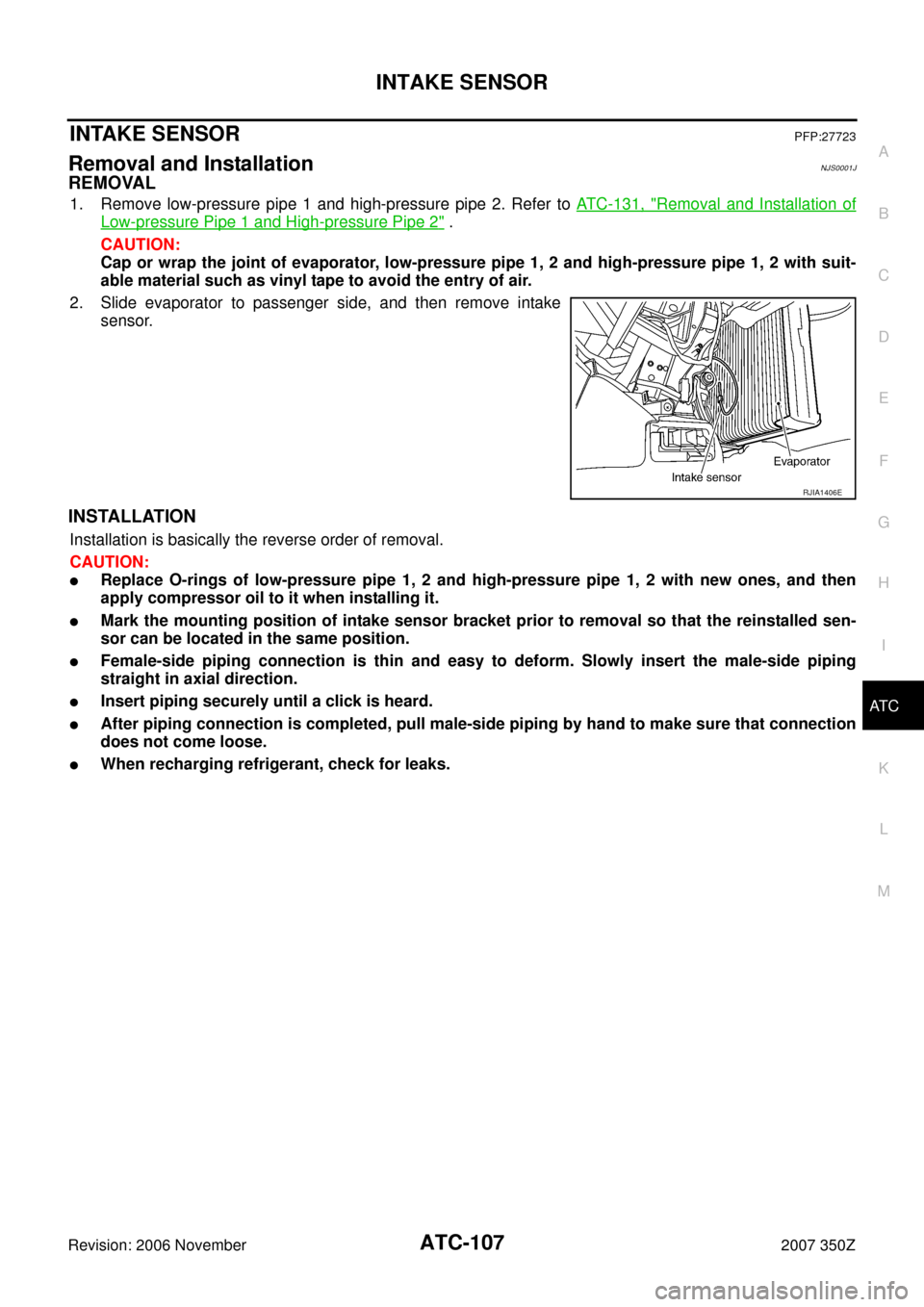
INTAKE SENSOR
ATC-107
C
D
E
F
G
H
I
K
L
MA
B
AT C
Revision: 2006 November2007 350Z
INTAKE SENSORPFP:27723
Removal and InstallationNJS0001J
REMOVAL
1. Remove low-pressure pipe 1 and high-pressure pipe 2. Refer to ATC-131, "Removal and Installation of
Low-pressure Pipe 1 and High-pressure Pipe 2" .
CAUTION:
Cap or wrap the joint of evaporator, low-pressure pipe 1, 2 and high-pressure pipe 1, 2 with suit-
able material such as vinyl tape to avoid the entry of air.
2. Slide evaporator to passenger side, and then remove intake
sensor.
INSTALLATION
Installation is basically the reverse order of removal.
CAUTION:
�Replace O-rings of low-pressure pipe 1, 2 and high-pressure pipe 1, 2 with new ones, and then
apply compressor oil to it when installing it.
�Mark the mounting position of intake sensor bracket prior to removal so that the reinstalled sen-
sor can be located in the same position.
�Female-side piping connection is thin and easy to deform. Slowly insert the male-side piping
straight in axial direction.
�Insert piping securely until a click is heard.
�After piping connection is completed, pull male-side piping by hand to make sure that connection
does not come loose.
�When recharging refrigerant, check for leaks.
RJIA1406E
Page 112 of 142
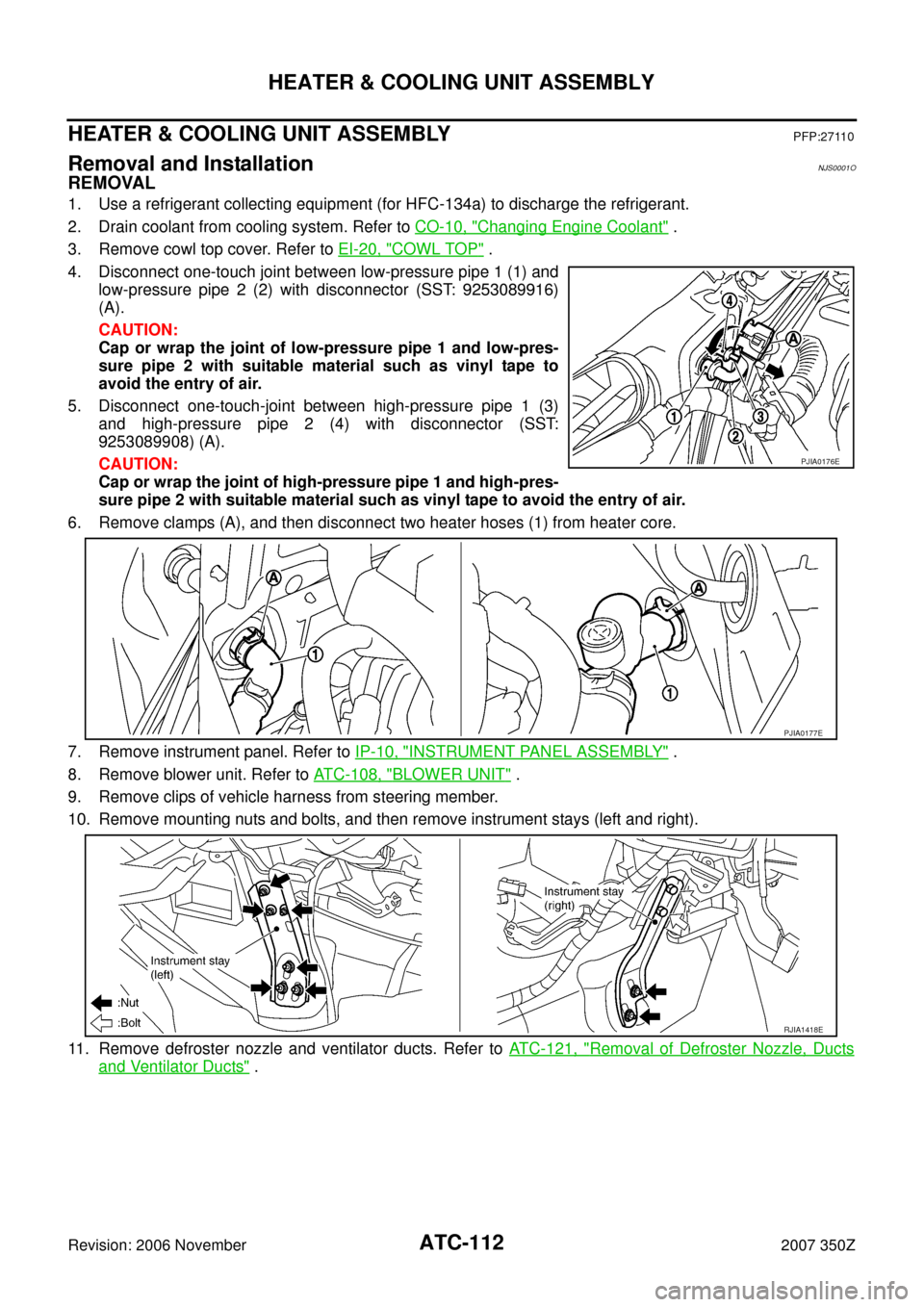
ATC-112
HEATER & COOLING UNIT ASSEMBLY
Revision: 2006 November2007 350Z
HEATER & COOLING UNIT ASSEMBLYPFP:27110
Removal and InstallationNJS0001O
REMOVAL
1. Use a refrigerant collecting equipment (for HFC-134a) to discharge the refrigerant.
2. Drain coolant from cooling system. Refer to CO-10, "
Changing Engine Coolant" .
3. Remove cowl top cover. Refer to EI-20, "
COWL TOP" .
4. Disconnect one-touch joint between low-pressure pipe 1 (1) and
low-pressure pipe 2 (2) with disconnector (SST: 9253089916)
(A).
CAUTION:
Cap or wrap the joint of low-pressure pipe 1 and low-pres-
sure pipe 2 with suitable material such as vinyl tape to
avoid the entry of air.
5. Disconnect one-touch-joint between high-pressure pipe 1 (3)
and high-pressure pipe 2 (4) with disconnector (SST:
9253089908) (A).
CAUTION:
Cap or wrap the joint of high-pressure pipe 1 and high-pres-
sure pipe 2 with suitable material such as vinyl tape to avoid the entry of air.
6. Remove clamps (A), and then disconnect two heater hoses (1) from heater core.
7. Remove instrument panel. Refer to IP-10, "
INSTRUMENT PANEL ASSEMBLY" .
8. Remove blower unit. Refer to ATC-108, "
BLOWER UNIT" .
9. Remove clips of vehicle harness from steering member.
10. Remove mounting nuts and bolts, and then remove instrument stays (left and right).
11. Remove defroster nozzle and ventilator ducts. Refer to ATC-121, "
Removal of Defroster Nozzle, Ducts
and Ventilator Ducts" .
PJIA0176E
PJIA0177E
RJIA1418E
Page 113 of 142
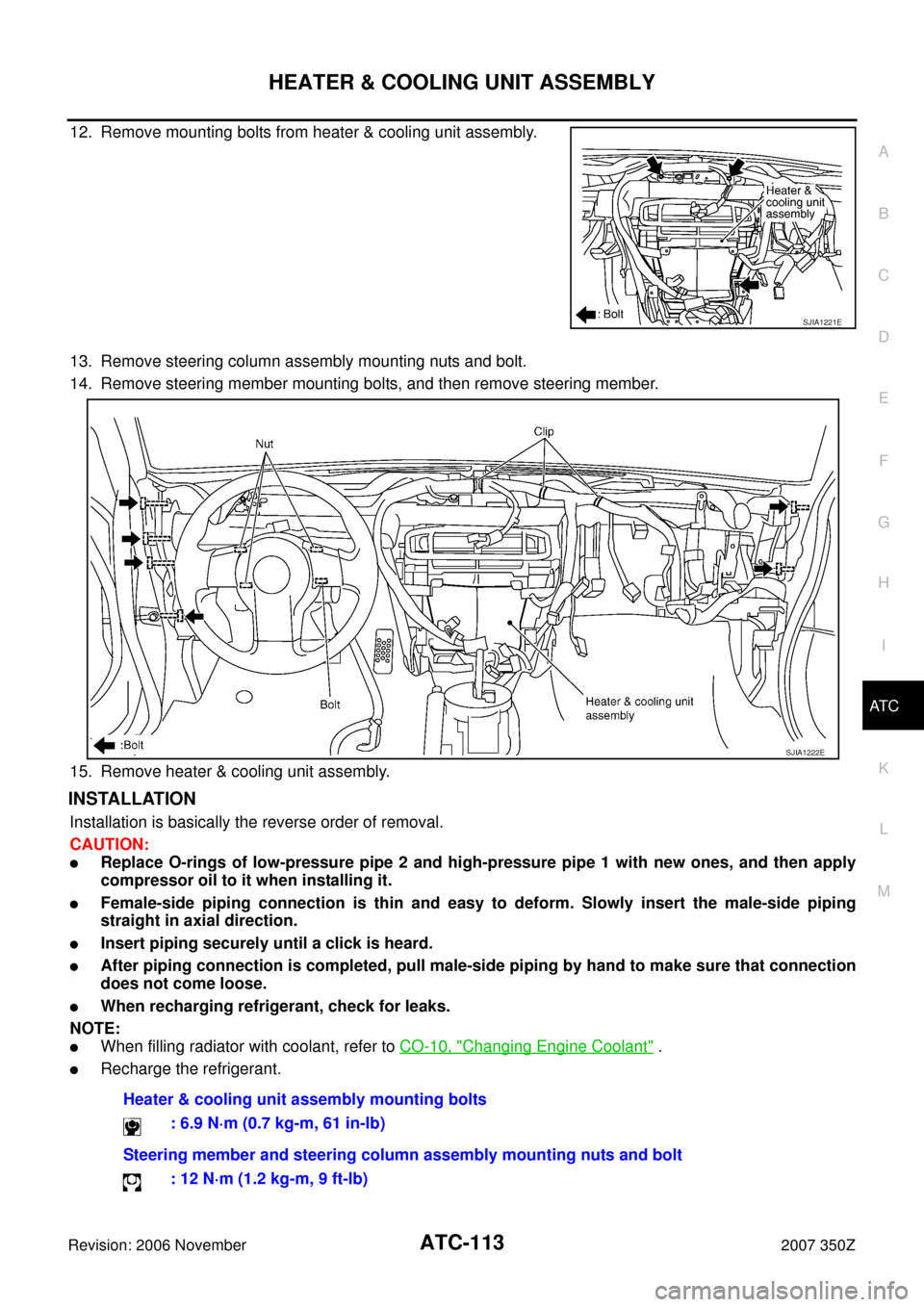
HEATER & COOLING UNIT ASSEMBLY
ATC-113
C
D
E
F
G
H
I
K
L
MA
B
AT C
Revision: 2006 November2007 350Z
12. Remove mounting bolts from heater & cooling unit assembly.
13. Remove steering column assembly mounting nuts and bolt.
14. Remove steering member mounting bolts, and then remove steering member.
15. Remove heater & cooling unit assembly.
INSTALLATION
Installation is basically the reverse order of removal.
CAUTION:
�Replace O-rings of low-pressure pipe 2 and high-pressure pipe 1 with new ones, and then apply
compressor oil to it when installing it.
�Female-side piping connection is thin and easy to deform. Slowly insert the male-side piping
straight in axial direction.
�Insert piping securely until a click is heard.
�After piping connection is completed, pull male-side piping by hand to make sure that connection
does not come loose.
�When recharging refrigerant, check for leaks.
NOTE:
�When filling radiator with coolant, refer to CO-10, "Changing Engine Coolant" .
�Recharge the refrigerant.
SJIA1221E
SJIA1222E
Heater & cooling unit assembly mounting bolts
: 6.9 N·m (0.7 kg-m, 61 in-lb)
Steering member and steering column assembly mounting nuts and bolt
: 12 N·m (1.2 kg-m, 9 ft-lb)
Page 123 of 142
REFRIGERANT LINES
ATC-123
C
D
E
F
G
H
I
K
L
MA
B
AT C
Revision: 2006 November2007 350Z
REFRIGERANT LINESPFP:92600
HFC-134a (R-134a) Service ProcedureNJS0001U
SETTING OF SERVICE TOOLS AND EQUIPMENT
Discharging Refrigerant
WARNING:
Avoid breathing A/C refrigerant and lubricant vapor or mist. Exposure may irritate eyes, nose and
throat. Remove HFC-134a (R-134a) from A/C system using certified service equipment meeting
requirements of SAE J-2210 [HFC-134a (R-134a) recycling equipment] or J-2209 [HFC-134a (R-134a)
recovery equipment]. If accidental system discharge occurs, ventilate work area before resuming ser-
vice. Additional health and safety information may be obtained from refrigerant and lubricant manu-
facturers.
Evacuating System and Charging Refrigerant
WJIA0614E
WJIA0615E
Page 124 of 142
ATC-124
REFRIGERANT LINES
Revision: 2006 November2007 350Z
*1ATC-21, "LUBRICANT RETURN
OPERATION"
*2ATC-138, "Checking for Refrigerant
Leaks"
*3ATC-140, "CHECKING PROCE-
DURE"
*4ATC-83, "PERFORMANCE TEST
DIAGNOSIS"
*5AT C - 5 , "CONTAMINATED REFRIG-
ERANT"
SJIA1275E
Page 125 of 142
REFRIGERANT LINES
ATC-125
C
D
E
F
G
H
I
K
L
MA
B
AT C
Revision: 2006 November2007 350Z
ComponentsNJS0001V
Refer to AT C - 7 , "Precautions for Refrigerant Connection" .
Removal and Installation of CompressorNJS0001W
REMOVAL
1. Use a refrigerant collecting equipment (for HFC-134a) to discharge the refrigerant.
2. Remove tower bar. Refer to FSU-20, "
TOWER BAR" .
SJIA1885E
PJIA0174E
: N·m (kg-m, ft-lb)
Page 126 of 142
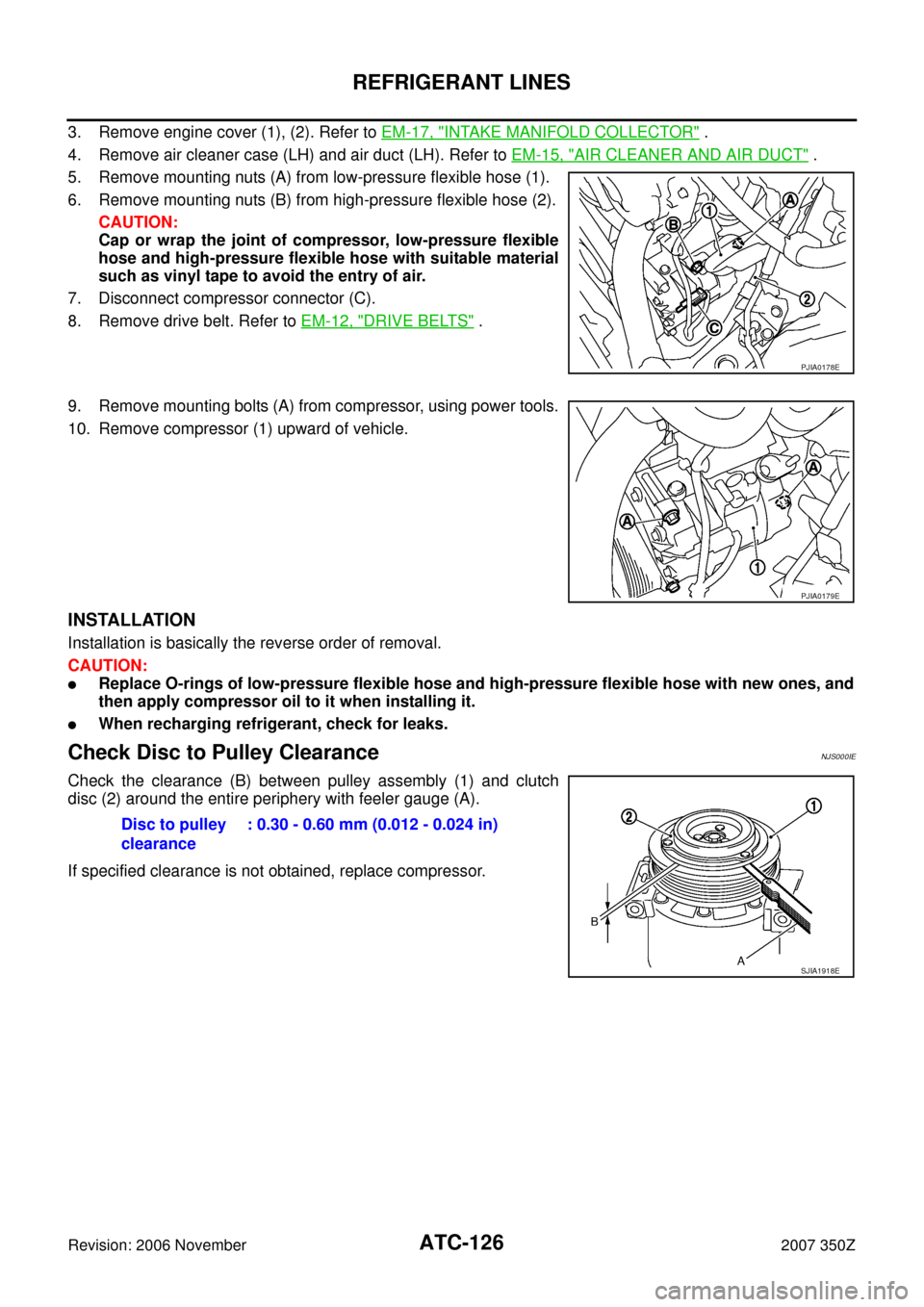
ATC-126
REFRIGERANT LINES
Revision: 2006 November2007 350Z
3. Remove engine cover (1), (2). Refer to EM-17, "INTAKE MANIFOLD COLLECTOR" .
4. Remove air cleaner case (LH) and air duct (LH). Refer to EM-15, "
AIR CLEANER AND AIR DUCT" .
5. Remove mounting nuts (A) from low-pressure flexible hose (1).
6. Remove mounting nuts (B) from high-pressure flexible hose (2).
CAUTION:
Cap or wrap the joint of compressor, low-pressure flexible
hose and high-pressure flexible hose with suitable material
such as vinyl tape to avoid the entry of air.
7. Disconnect compressor connector (C).
8. Remove drive belt. Refer to EM-12, "
DRIVE BELTS" .
9. Remove mounting bolts (A) from compressor, using power tools.
10. Remove compressor (1) upward of vehicle.
INSTALLATION
Installation is basically the reverse order of removal.
CAUTION:
�Replace O-rings of low-pressure flexible hose and high-pressure flexible hose with new ones, and
then apply compressor oil to it when installing it.
�When recharging refrigerant, check for leaks.
Check Disc to Pulley ClearanceNJS000IE
Check the clearance (B) between pulley assembly (1) and clutch
disc (2) around the entire periphery with feeler gauge (A).
If specified clearance is not obtained, replace compressor.
PJIA0178E
PJIA0179E
Disc to pulley
clearance: 0.30 - 0.60 mm (0.012 - 0.024 in)
SJIA1918E
Page 127 of 142
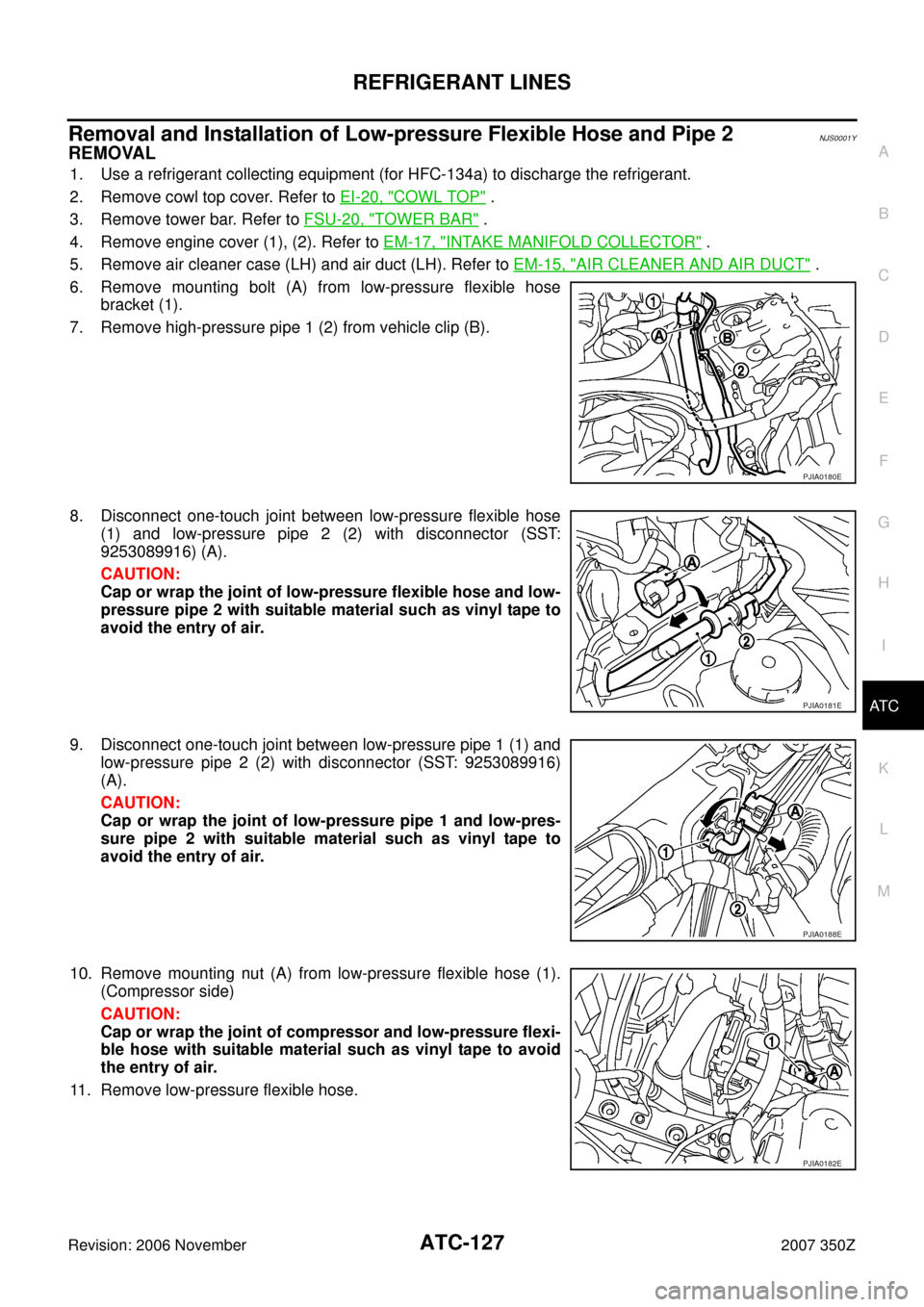
REFRIGERANT LINES
ATC-127
C
D
E
F
G
H
I
K
L
MA
B
AT C
Revision: 2006 November2007 350Z
Removal and Installation of Low-pressure Flexible Hose and Pipe 2NJS0001Y
REMOVAL
1. Use a refrigerant collecting equipment (for HFC-134a) to discharge the refrigerant.
2. Remove cowl top cover. Refer to EI-20, "
COWL TOP" .
3. Remove tower bar. Refer to FSU-20, "
TOWER BAR" .
4. Remove engine cover (1), (2). Refer to EM-17, "
INTAKE MANIFOLD COLLECTOR" .
5. Remove air cleaner case (LH) and air duct (LH). Refer to EM-15, "
AIR CLEANER AND AIR DUCT" .
6. Remove mounting bolt (A) from low-pressure flexible hose
bracket (1).
7. Remove high-pressure pipe 1 (2) from vehicle clip (B).
8. Disconnect one-touch joint between low-pressure flexible hose
(1) and low-pressure pipe 2 (2) with disconnector (SST:
9253089916) (A).
CAUTION:
Cap or wrap the joint of low-pressure flexible hose and low-
pressure pipe 2 with suitable material such as vinyl tape to
avoid the entry of air.
9. Disconnect one-touch joint between low-pressure pipe 1 (1) and
low-pressure pipe 2 (2) with disconnector (SST: 9253089916)
(A).
CAUTION:
Cap or wrap the joint of low-pressure pipe 1 and low-pres-
sure pipe 2 with suitable material such as vinyl tape to
avoid the entry of air.
10. Remove mounting nut (A) from low-pressure flexible hose (1).
(Compressor side)
CAUTION:
Cap or wrap the joint of compressor and low-pressure flexi-
ble hose with suitable material such as vinyl tape to avoid
the entry of air.
11. Remove low-pressure flexible hose.
PJIA0180E
PJIA0181E
PJIA0188E
PJIA0182E